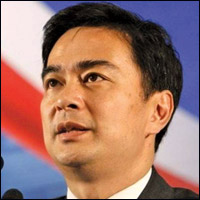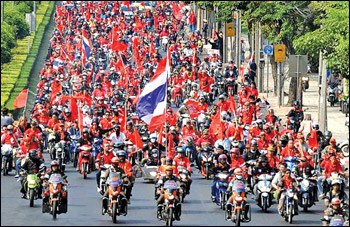Cracks in the citadel
P.S. SURYANARAYANA Singapore
The events following the Bangkok
clashes signal an erosion in the army’s support to Prime Minister
Abhisit Vejjajiva.
Thailand has, in recent years, become a byword for political
instability and negation of democracy. Clashes between security forces
and anti-government protesters on the streets of Bangkok in early April
worsened this image.
|

Prime Minister
Abhisit Vejjajiva |

Former Prime Minister
Thaksin Shinawatra |
The April 10 showdown was the worst since the anti-military riots of
1992 in Bangkok. Abhisit Vejjajiva, a suave leader of the Democrat
Party, was the target of the protesters’ ire. His suspected link to the
Thai military bloc as its civilian proxy was not the sole reason for
such fury. More infuriating to the protesters was the perceived manner
in which he gained back-door entry to Thai politics as Prime Minister in
2009.
Solid foundation
For the Oxford-educated Abhisit, who drew inspiration from the
writings of the Nobel laureate Amartya Sen, among others, the latest
episode in Thailand’s crisis of democracy could not have been more
acute. Yet, on April 12, when Thai Army Commander-in-Chief Anupong
Paochinda declared his preference for ‘peace’ and suggested
‘dissolution’ of the House of Representatives as a potential
crisis-buster, Abhisit’s critics saw cracks in his political citadel,
which was believed to have been built on a solid foundation of the
military’s support.
As this report was being written, before the mid-April national
festive season, there were many serious questions that came to the fore.
Was the army beginning to dump Abhisit as a leader unworthy of continued
support? Was Thailand doing a full circle insofar as the army’s
political ascendance in late 2006 was concerned? If so, the army could
be seeking an apolitical role. Also, was the army, having ‘bungled’ its
2006 coup, beginning to realize the potency of ‘people’s power’?
The frenetic events of late March and early April were almost
entirely traceable to the circumstances of Thailand’s considerable
exposure to the current wave of political globalization. Indeed, General
Anupong’s April 12 comments seemed to have been a response to the
potential global criticism of a possible full-scope crackdown on the
anti-government protesters.
The lead-up to Anupong’s statesman-like comments was long and
politically complex, too. By then the anti-Abhisit protesters had
mobilised people in huge numbers for rallies and pickets on an
almost-daily basis from mid-March. In a more fundamental sense, it was
also becoming clear that Thailand’s crisis of democracy could be traced
to the penchant of the country’s military to stage coups.
|

The protest that left |
|

A red shirt supporter |
|

Protest taking place |
The spark that ignited the protest rallies in late March and early
April was former Prime Minister Thaksin Shinawatra’s sense of
helplessness over a verdict of the Supreme Court on February 27 that
nearly $1.4-billion worth of his assets be seized by the state.
This amounted to a significant proportion of his assets, which were
frozen following the coup against him in September 2006.
The court passed the order on the basis of a finding that he had
resorted to large-scale ‘abuse of power’ as Prime Minister for two
times. Thaksin, who is in exile and has professed innocence all along,
began a push for his ‘vindication’ at home through political moves from
his bases.
He was at the United Nations when the coup against him was staged in
2006 and saw, on television in his New York hotel room, his own downfall
in the cameos of coup-related actions in Bangkok. He began his
self-imposed exile in those circumstances, and returned home briefly
when his political ally was Thailand’s Prime Minister for a short while
following the ‘democracy-restoring election’ that the junta held in
December 2007. Later, while travelling abroad, he jumped bail in a case
against him in Bangkok and began another spell of self-imposed exile,
which has continued to this day.
Thaksin’s supporters, often encouraged and even tutored by him from
his bases through video-link addresses on the logic and logistics of
protest, were as ready in mid-March as at any time before for a
showdown.
A series of earlier protest rallies and actions had all come to
naught, as seen from his standpoint. His supporters, banded under the
banner of the United Front for Democracy against Dictatorship (UDD), are
known as the Red Shirts, so named after the colour of their attire.
Before the rallies in March-April in Bangkok, the UDD staged a
particularly significant show of protest that turned out to be a major
international attention grabber. The protesters stormed the venue of a
regional summit that Abhisit was hosting in the Thai countryside in
April 2009. The meeting was totally disrupted and he cut a truly sorry
figure. The primary aim of Thaksin and his supporters at that time was
to “deny” Abhisit the pleasure of playing a regional statesman after
having come to power, in their view, by riding on the shoulders of the
military leaders and their civilian minions.
Abhisit’s ascent as Prime Minister was the result of political
permutations and combinations in the House of Representatives, which was
constituted in the wake of the December 2007 poll held by the
coup-masters. And, in the lead-up to Abhisit’s ascent, two successive
Prime Ministers, who were both associated with Thaksin, were unseated
through court orders in the context of protest rallies against him.
Thaksin and his followers saw those rallies as the handiwork of the
military and civilian forces opposed to him and jealous of his
popularity among the rural masses.
Opportunity for protest
From Thaksin’s perspective, an all-out offensive against Abhisit and
his presumptive godfathers in the military establishment was required in
such circumstances. The verdict in the assets seizure case was an
“opportunity for protest” that Thaksin did not want to miss. That
decided the political complexion of the protest rallies against Abhisit.
The UDD surprised the military establishment, the civil service and
other elite groups and even the civilian political class by launching
and sustaining what turned out to be virtually a movement and not just a
string of rallies.
For almost a month, there was no breach of the peace by UDD activists
and rank-and-file protesters, most of them from among the poor masses
who were reaping the benefits of Thaksin’s populist policies when he was
toppled. On a Sunday during this period, the number of UDD protesters
across Bangkok exceeded 100,000, according to some unofficial estimates.
The authorities, too, did not deny such a figure.
Right at the beginning of this campaign, Abhisit deployed an
estimated 50,000 troops and other security personnel. He also armed
himself with powers under an Internal Security Act, which was enacted in
some controversial political circumstances.
Blood donation drive
As the UDD campaign progressed, rallies remained peaceful and were
confined to a few historical sites and high-profile areas of modern
interest. At one stage, the protesters picketed near an infantry
headquarters, but no confrontation ensued as both sides exercised
restraint.
To sustain the momentum of the protest, the UDD launched a blood
donation drive. Several containers of the donated blood were later
splashed at the premises of the Prime Minister’s office, his residence,
and his party headquarters. This ‘innovative’ protest, driven by the
concept of ‘sweat and blood’, also passed off peacefully.
As the UDD showed no signs of relenting in its campaign, Abhisit
declared a state of emergency in Bangkok and a few neighbouring areas on
April 7. A political gamble meant to subdue the protesters, it only
served to raise the stakes as seen from the UDD perspective. The
soldiers and other security personnel were also under pressure from some
sections of civil society to act decisively by using the emergency
powers.
Clashes
It was in such a milieu that clashes broke out between the security
forces and UDD activists on April 10 at two or three locations in
Bangkok. It was not immediately clear who triggered these clashes. The
rallying cries of the protesters were calls for Abhisit’s resignation,
the dissolution of the House of Representatives, and snap general
elections.
The ferocious clashes on that day left a trail of casualties. Over 20
people, mostly protesters, and at least four military personnel,
including a senior officer, were killed. Unofficial estimates placed the
number of injured at over 850.
Following the fatalities, the army proposed a ‘retreat’ or, more
precisely, a pullback from forward deployment. The proposal was
implemented and the protesters were asked to reciprocate by vacating
their camp sites. But the UDD leaders would not budge. Sensing that they
had ‘won’ at least one round in the battle of attrition, they organised
a somewhat solemn funeral rally for the dead on their side. The mood on
the side of the security forces was, in contrast, one of dismay.
The army was accused of using live ammunition for crowd control.
Denying this, the military establishment and Abhisit maintained that the
security forces had used live bullets only for firing warning shots and
only in self-defence when attacked. The UDD sought to trash the claim
that the security forces used rubber bullets after tear gas and water
cannons had failed to control the crowds. Abhisit alleged that
“terrorists” had infiltrated the ranks of the protesters in a bid to
hurt Thailand.
In an amazing, though indirect, admission of failure, a Thai Army
spokesman said on April 11 that an order had been issued to “monitor the
health and morale” of the military personnel in the context of the
previous day’s clashes with UDD protesters.
In a uniquely Thai tradition, the people, including soldiers, look to
the much-revered constitutional monarch, King Bhumibol Adulyadej, for
guidance in a national crisis. Until April 12, the King made no comment
by way of an instructive parable or a definitive directive.
With at least one foreigner, a Japanese cameraman covering the event,
reported killed by ‘live fire’ during the clashes, the Thai authorities
found themselves in a particularly hot seat. An official probe into all
aspects of the clashes was ordered.
For Thailand, the external fallout of the prolonged crisis was not
confined to a Japanese victim. The Association of Southeast Asian
Nations (ASEAN), one of whose founding members is Thailand, became
seriously concerned. An elaborate comment by the Singapore Foreign
Ministry echoed the sentiments of several other ASEAN member-states as
well.
“If the situation [in Bangkok] is unresolved, it will have serious
implications for Thailand’s future and the future of the ASEAN.
Singapore hopes that all Thais, whatever their political views, will
place the interests of the country first and reach a durable compromise
that will enable Thailand to return to normality as soon as possible.
This is important not just for the Thai people but also for the ASEAN
as a community. The ASEAN cannot progress if one of its most important
members remains mired in political instability.” Such plain-speak
diplomacy, very rare in the courtesy-bound and
national-sovereignty-conscious ASEAN, was a telltale commentary on the
Thai crisis.
The Frontline |



